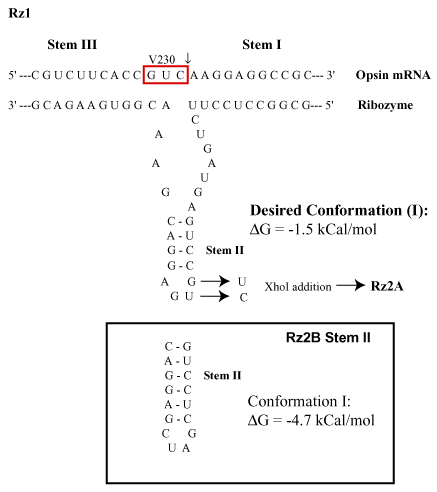![]() Figure 1 of
Sullivan, Mol Vis 2002;
8:102-113.
Figure 1 of
Sullivan, Mol Vis 2002;
8:102-113.
Figure 1. Design of first and second generation anti-V230 KD hRzs
The catalytic consensus core of the hRz is embraced by the AS flanks (5': 11 nt; 3': 12 nt) to create the first generation anti-V230 hRz. The AS flanks base pair with the opsin mRNA to form Stems I and III. The GUC` cleavage site is shown (red box). The folding energy of the active conformation (shown) of the first generation hRz is shown. The AS flanks of the first generation hRz were maintained in second generation hRzs (Rz2A and Rz2B). To create Rz2A two nucleotides in the Stem II tetraloop that were predicted to cause first generation hRz misfolding and inactivity were replaced (arrows) to generate a unique XhoI site for the hRz plasmid (pCDNA3). Rz2A has four base pairs in Stem II and the expected conformation was the most stable structure (DG=-1.5 kCal/mol) relative to random coil. To create Rz2B the XhoI site was restricted, filled-in and religated to extend Stem II (inset) from four to six base pairs. DG of folding of Rz2B is -4.7 kCal/mol or -3.2 kCal/mol more stabile than Rz2A.
